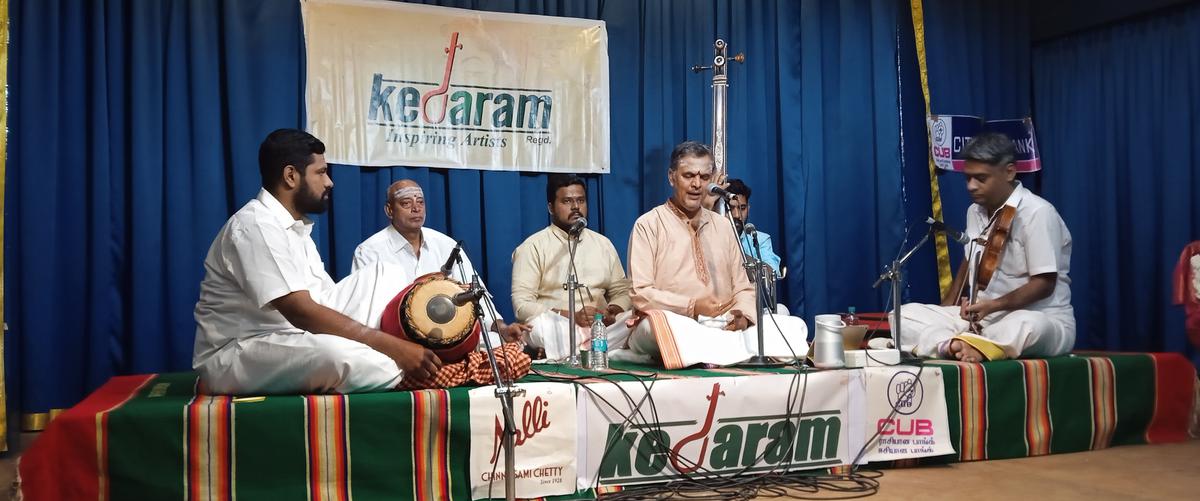
A.S. Murali with A.G. Venkatasubramaniam (violin); Tirucherai Kaushik on the mridangam and Madipakkam Murali on the ghatam.
| Photo Credit: Special Arrangement
A.S. Murali’s sonorous voice, energetic rendition and clear diction draw you into his music almost instantly. A music lecturer at Kalakshetra Foundation, Murali performed at the Kedaram Isai, dedicated to guru par excellence P.S. Narayanaswamy.
Belonging to the Semmangudi Srinivasa Iyer bani, Murali opened the concert with the customary varnam ‘Sami ninne’ in raga Sri. The varnam, studded with complex musical exercises, infused an energy into the concert. Rendered in madhyama kalam for the pallavi and anupallavi portions, the varnam moved to melkalam for the charanam.
A compact and ardent Tamil composition by Tiruvarur Ramalingaswami, dedicated to Lord Ganesha and set to raga Gowla, was soulful. The swaraprastara with catchy patterns enriched the tempo of the composition. A succinct but memorable alapana for raga Husseni was followed by the Tyagaraja kriti, ‘Rama ninne nammi naanu’.
In ‘Ennaganu ramabhajana’ in Kamavardhini/Pantuvarali, a lot was conveyed in the alapana that was not too long. In fact, the alapana resonated the beseeching quality that is inherent in the kriti. The niraval at ‘Prema meera’ was poignant.
Murali expounded some of the stunning phrases with the niraval almost attaining the status of a kriti.
His training in ghatam could be seen in the way he handled the swaraprastara portion – moving effortlessly through different mathematical combinations. The central piece of the concert was set to raga Sankarabharanam. Hailed by scholars as the most superior among ragas, this sarva swara gamaka raga provided enormous scope for elaboration. Murali went ahead with a grand exposition of Sankarabharanam. Detailed and evocative, the alapana brought to the fore Murali’s imagination and perfect execution.
Murali rendered the Tyagaraja kriti ‘Enduku peddala’ and as is the hallmark of the Semmangudi style, the rendition was lucid. The niraval at ‘Veda sastra’ reminded one of Semmangudi’s AIR concert, in which he rendered this kriti, with niraval at the same spot. The brisk and energetic swaraprastara embarking on several permutations and combinations gave a special edge to the piece. The swaras grew into a torrent.

A.S. Murali with A.G. Venkatasubramaniam (violin); Tirucherai Kaushik on the mridangam and Madipakkam Murali on the ghatam.
| Photo Credit:
Special Arrangement
A.G. Venkatasubramaniam’s (violin) interpretation of ragas Kamavardhini and Sankarabharanam had a stately quality to it. He played with a lot of composure without trying to impress. Tirucherai Kaushik on the mridangam and Madipakkam Murali on the ghatam played with restraint and poise.
Murali was accompanied by his disciples. These days, when most concerts are a show of virtuosity, a concert such as this which rests on commitment to classicism was an aural treat.
Stay connected with us on social media platform for instant update click here to join our Twitter, & Facebook
We are now on Telegram. Click here to join our channel (@TechiUpdate) and stay updated with the latest Technology headlines.
For all the latest Entertainment News Click Here
For the latest news and updates, follow us on Google News.
